Blue Jays 2010 .. if you build a better team will the fans come back?
Apr 12th, 2010 | By Rob Sparrow | Category: Sporting Life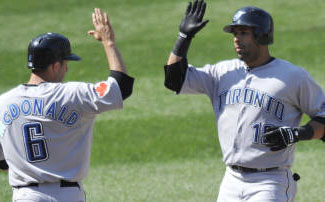
Blue Jays’ Jose Bautista (r) is congratulated by John McDonald after hitting two-run homer during eighth inning against Baltimore Orioles, Sunday, April 11, 2010 in Baltimore. The Jays won 5-2. AP Photo/Gail Burton.
According to www.yourdictionary.com there are three main meanings for fans/fanatics: 1. a person whose enthusiasm or zeal for something is extreme or beyond normal limits; 2. a person devoted to a particular hobby or pastime; 3. a person motivated by irrational exuberance.
However you define them, fans are the lifeblood and support of any professional sports organization. At the best of times these fanatics provide a city with its identity and give reason for a team’s existence. But what happens when malaise creeps into place?  What happens when an organization through its policies and personnel moves alienates its core base of fans, and indifference and apathy start to become the norm?
In this case the fan base can erode, somewhat subtly at first, but then it hits you. All of a sudden you look around and scan the seats at the ball park formerly known as the Skydome, where once there were crowds of 50,000 every night. Last year’s Toronto Blue Jays’ attendance of around 10,000 provided scenes eerily reminiscent of the woeful last days of the Montreal Expos. It’s a firm reminder that at the furthest extreme fan indifference can be a death nail, that threatens the very existence of a sports franchise. Yet the seeds of indifference are planted a long time before, in lost hope and empty dreams.
The Blue Jays are not alone when it comes to lost hopes, in this the largest city of the Canadian great white north. Indeed, the Blue Jays are somewhat of a microcosm of the last lost decade in Toronto sports. For the past 10 years a lot has been promised but nothing has been delivered:
|
Major Professional North American Sports Cities (2000-2009) |
|||
| Team |
Playoffs Appearances |
Finals |
Championships |
| Los Angeles* |
25 |
12 |
6 |
| Boston |
24 |
7 |
6 |
| New York** |
33 |
7 |
3 |
| Detroit |
19 |
6 |
3 |
| Miami |
12 |
2 |
2 |
| Philadelphia |
26 |
4 |
1 |
| Denver |
19 |
2 |
1 |
| Chicago*** |
15 |
2 |
1 |
| Phoenix |
14 |
2 |
1 |
| Minnesota |
17 |
0 |
0 |
| Atlanta |
12 |
0 |
0 |
| Washington |
11 |
0 |
0 |
| Toronto**** |
10 |
0 |
0 |
* Los Angeles (includes 2 Hockey & Baseball teams but no NFL team)
** New York (includes 2 Hockey, Baseball, Basketball, Football teams)
*** Chicago (includes 2 Baseball teams)
**** Toronto (includes the NFL Buffalo Bills – the city’s regional team)
Now, for all they are worth, the Toronto Maple Leafs will always have an unshakeable following. “Leafs nation” will continue to support their team, and the coffers of the Ontario Teachers Pension Plan for that matter, with an irrational exuberance quite unsuited to a team that hasn’t won the big prize in over 40 years.
But what about the other sports that don’t have such a pedigree and cultural history with the populace. They are much more vulnerable to fan whims. Quite simply, gone are the days where the Blue Jays had a magical presence within the city, a time when baseball was relevant and a part of the cities conversation. That has changed and the winds have indeed shifted. The question is, how did we get here?
How we got here — J.P. Riccardi’s reign of error…
Once upon a time Toronto was the model franchise for all of baseball, but then along came the reign of general manager J.P. Ricciardi in the first decade of the 21st century. He swept into town and immediately upon his hiring tore up the baseball scouting department that was the backbone to a farm system that had produced more players than any in baseball for more than a decade.
And after announcing upon his arrival that he had learned in Oakland how to succeed on a limited budget, he proved his lessons hadn’t hit home because the Jays faded into oblivion. And once they did, Ricciardi began to whine that he couldn’t compete with the big bucks of Boston and the Yankees, even though in 2008 Tampa Bay showed those two big-spenders were not invincible.
Yet it was not only the bad contracts (see Vernon Wells, Alex Rios, A.J. Burnett, B.J. Ryan etc.) that marred his tenure, it was also his constant excuses for the Blue Jay’s failures (i.e. injuries, tough division, payroll limitations, etc, etc) and the way he treated people both inside and outside the organization.  This was captured in his now infamous decree: “it isn’t a lie if we know the truth” – a line that became a lightening rod for his disrespect for the baseball fans of Toronto, and served to sour the enthusiasm of core Blue Jays’ supporters.
Two examples from the past year that ultimately sealed Ricciardi’s fate with the ball club come to mind. The first was the Roy Halladay trade-deadline fiasco in July 2009. Halladay had been for a long time the team’s best player and had epitomized what was once great about the Blue Jays. He was the face and figurehead of the organization. Like Mats Sundin of the hockey Leafs, Halladay would have loved to win a championship with Toronto. When that became entirely improbable, and the organization tried to use its best bargaining chip to generate a return on future prospects, he handled the situation with aplomb and grace.
What transpired from the team management’s end, however, was much less than graceful. J.P Ricciardi went very public with his demands for Halladay and created a three-ring circus that the pitcher had to endure, leading up to the season’s trade deadline. Despite Halladay’s classy support of Ricciardi, it was Ricciardi who created an unnecessary maelstrom. He twisted circumstances and chronology so as to force Halladay to choose between saying he would gratefully remain in Toronto for a home-team discount, and making it seem to the public that he was an ungrateful villain bound and determined to leave in free agency. It just wasn’t right.
No honourable team makes its best player declare his intentions to renew or not a year-and-a-half before a contract expires. What you do if you are playing the game the proper way is try and get your team competitive before your most valuable player’s contract ends. Show him you mean business and convince him to stay. It was both disingenuous and rotten for Ricciardi to twist words and pass the blame of failure on to the player.
The second instance that ultimately even Ricciardi could not survive was the late-year insurrection within the clubhouse. On the last Friday of the regular season in Baltimore, it was leaked to the media that the current group of players were unhappy about how they were treated during the year – and how they could continue to move forward if Cito Gaston stayed on.
Suspiciously, and quite out of character, Ricciardi chose to stay silent and outside the spotlight, further exasperating a situation that needed to be defused by managements leadership. The next day Blue Jay President Paul Beeston flew into town and called the team’s leaders together and stared them down asking for clarity. He asked the leaders of the mutiny to declare themselves. All he found was dead silence and back-tracking within the room. So this was all a media concoction? Very interesting indeed that Ricciardi was not allowed in the room that day and that he was relieved of his duties that very afternoon – one day before the end of the 2009 regular season, the eighth in his reign of mediocrity and error.
Baseball’s systemic imbalances … a plea for parity …
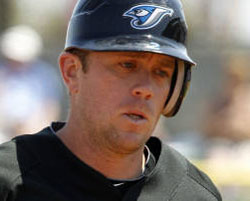
Aaron Hill rounds the bases after hitting a two-run homer run off Philadelphia Phillies (and foprmer Blue Jays) pitcher Roy Halladay, during pring training game in Clearwater, Fla., Wednesday, March 31, 2010. AP Photo/Gene J. Puskar.
Toronto hasn’t reached the playoffs even once in the wild card era (1995 to present). So strong is the concentration of power in this era that Boston and New York have made 23 of a possible 30 playoff appearances. In information compiled by USA Today, the Blue Jays opening day payroll stands at $62.23M (all figures US), ranking 22nd of 30 in major-league baseball. The Yankees lead the way at $206.33 million, while the Pirates rank 30th at $34.94 million. That huge discrepancy plays itself out every day in terms of team expectations and results. Baseball’s Competition Committee needs to address this disparity for the good of the game.
Baseball can look to other sports for direction. In hockey it was the general consensus that when the NHL moved to establish a firm league-wide salary cap, during the lockout of 2004-05, it was to control escalating costs and create league-wide parity. The essential point was to give smaller market franchises, some of which were teetering on bankruptcy, the cost certainty and financial ability to compete with the larger more established hockey markets. This helped fans believe, after many years, that a small market team such as Edmonton, which had continually sold its young talent away, had a chance against the big boys.
And indeed, it was those big markets that would suffer the most, as high spending big market teams like the Toronto Maple Leafs and New York Rangers could not spend themselves out of the mismanagement that had plagued them for years. They would have to compete on a level plane. And it was no mistake that in these new economic realities the Maple Leafs have not been to the playoffs since the salary cap began.
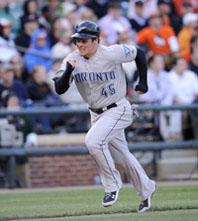
Travis Snider runs home to score the game-winning run during the ninth inning in Baltimore, Friday, April 9, 2010. THE ASSOCIATED PRESS/Nick Wass.
Hockey’s  model for changing its game was based on the previous successes of both the NBA (basketball) and NFL (football). In these sports franchises in small cities like San Antonio (NBA) and Green Bay (NFL) could compete with the Los Angeles’s and New Yorks of the world. In fact, this idea of a balanced playing field was one of the most important factors in the success of the NFL, catapulting it to a dominant position in the North American sports landscape. On “any given Sunday” one team could feel that they could beat the opposition. Not only that, but competitive parity allowed Las Vegas and sports betting into the mix, fueling the explosive growth and interest in the game.
The same cannot be said about baseball where the hopes for many cities are over literally before the season starts. Disparity in team payrolls, such as that of the Yankees and Pirates, has created a league of haves and have-nots. And this is one of the main issues that weaken the game right now. Baseball needs a plan for parity.
To its credit, major-league baseball already has come a long way since expanding revenue-sharing and introducing a luxury tax in the 2002 labour agreement. Yet more work needs to be done – on the amateur draft, the conduct of low-revenue clubs, and possibly league realignment.
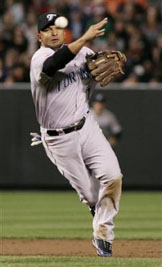
Jays’ shortstop Alex Gonzalez throws to first base to complete double play on Baltimore Orioles, April 10. REUTERS/Joe Giza.
So, what’s next?  There seems to be little political will for further increases in revenue sharing. The high-revenue teams are tired of funding certain low-revenue clubs that: a) decline to spend the money they are given; and b) cannot get out of their own way through mismanagement. Non-economic solutions seem to be one of the answers, and baseball does not lack possibilities.
The introduction of a worldwide draft and cap on draft-pick bonuses would better redistribute top amateur players to the teams that need them most. Fixing the draft is more complicated than it sounds, but Commissioner Bud Selig says the issue is now a priority.
Realignment, too, is complex and controversial. Commissioner Selig has long favored the idea, but he also favors an unbalanced schedule, the better to preserve rivalries. Such conflicts are inherent in virtually any realignment proposal: none will be perfect nor embraced by all.
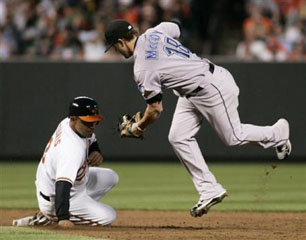
Jays’ second baseman Mike McCoy (r) tags out Orioles’ base runner Caesar Izturis on a stolen base attempt, April 10. REUTERS/Joe Giza.
But really, how difficult can this be? Find a way to give lesser clubs a better chance to compete. Tweak the schedule if necessary and expand the postseason by one wild card team in each league to enable more teams to qualify.
No one is foolish enough to suggest that market revenues and team payrolls aren’t a significant part of the competitive baseball landscape. And, indeed, the next labour negotiation will not simply be owners versus players, but as much about owners achieving consensus among themselves. This is the treacherous line Commissioner Bud Selig walks. Big-market owners like John Henry (the art collector owner of Boston) and Arte Moreno (the advertising magnet owner of the Los Angeles Angels) think they are providing welfare service for many small-market owners, while the latter believe they are simply fattening minnows for the sharks of the big markets.
Commissioner Selig is in the twilight of his career and in a position to cement his legacy. He led the sport out of the adversity of the 1994 strike and into prosperity. His final test is how he builds on success and leads the sport to some semblance of parity.
A new decade … a new direction …
Parity aside, with Ricciardi now history, the Blue Jays are going back to their roots, rebuilding a scouting staff that had been ravaged, trying to develop young players to compete with the New Yorks and Bostons of the world. Yet it is not an overnight success formula, and there are no false promises – of the sort that Jays fans grew tired of hearing from the old Ricciardi regime.
The watershed moment signaling a new direction was when the Jays dealt long-time ace Roy Halladay to the Phillies in the off-season for a parcel of prospects. Those prospects will help re-engergize an organization that was almost universally acknowledged (according to Baseball America) to be one of the worst farm systems in the game. New General Manager Alex Anthopoulos (a young Canadian baseball executive) has massively overhauled the scouting department, and positioned the team to have several high picks in this upcoming June’s amateur baseball draft.
Recently Anthopoulos said something profound about his philosophy of drafting. He declared he would rather get one or two stars every year for 10 years, than five serviceable major leaguers every year for 10 years. Ricciardi, it seemed, was the other way around, and in the end his drafting philosophy bore little fruit in wins and post-season appearances.
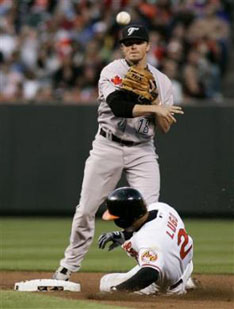
Mike McCoy throws to first to complete a double play after forcing out Orioles base runner Julio Lugo at second, April 10. REUTERS/Joe Giza.
In fact, over the past several years Ricciardi drafted some good players, but very few great ones. Also consider that five of the Jays’ top 10 prospects, as ranked by Baseball America, were obtained since July 30, 2009, and three of those were obtained in the first 100 days of the Alex Anthopoulos regime.
The Jays are committed then to continue in their new direction, and one way or another, they will turn veterans Jason Frasor, Scott Downs, and Lyle Overbay into younger pieces as they continue rebuilding. The team’s look is changing rapidly. By this time next season, the youngster Brett Wallace (part of the Halladay trade) could be at first base. Adeinis Hechevarria (a highly regarded Cuban defector) could be at shortstop. And J.P. Arencibia (the teams first-round pick of 2007) could be the everyday catcher.
In the interim, the Blue Jays will have to rely on young players in 2010, mold them in 2011-2012, then look to fine-tune and fill in the gaps with free agency, and then hopefully win again.  That’s not likely to sell many tickets in the short term. But rookie Jays GM Alex Anthopoulos, under the watchful eye of team president Paul Beeston, has put a strong plan in place to expedite the rebuild.
The 2010 Blue Jays … pitching concerns run deep …
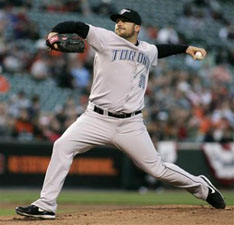
Dana Eveland pitched seven-plus shutout innings to help the Jays beat the Baltimore Orioles 3-0, Saturday, April 10, 2010. Reuters.
Any way you slice it, the Toronto Blue Jays’ current pitching staff is one of the most inexperienced pitching rotations in the history of the club. The loss of Halladay and the uncertainty of two starters who missed the entire 2009 season (Shaun Marcum and Dustin McGowan), make this one area a huge cause for concern. So patchwork is the pitching staff that when spring training opened in February, no fewer than 37 pitchers arrived to compete for 12 jobs. If that doesn’t spell out what’s going on in Toronto this season, nothing will.
Consider the following numbers, that outline how inexperienced and uncertain this collection of pitchers are:
|
Toronto Blue Jay — Key Pitching Metrics |
|
| The Numbers |
Reasons for Concern |
| 72 | The prospective starting rotation has 72 career wins, second lowest total of any Jay’s staff to start a season. The current Jays have two more career wins than the 1981 rotation of Jim Clancy, Dave Stieb, Luis Leal, Jackson Todd and Mark Bomback. Those Jays went 37-69 in the strike-marred season. |
| 24/19 | The Jays’ five-man rotation recorded a combined total of 24 wins in 2009. The seven-man bullpen notched a cumulative 19 victories in 2009. That is a total of 43 wins if each matched their output from last year. |
| 42 | The career highs for the 5-man rotation are 12 for Shaun Marcum and Dustin McGowan, 3 for Brandon Morrow, 13 for Ricky Romero and 2 for Marc Rzepczynski. That’s a total of 42 victories if they all hit their career highs. |
| 37 | The career average number of starts (37) by the Jays’ 2010 opening day rotation, is one more than Roy Halladay made in 2003 when he won the Cy Young Award. |
| 2 1/2 | The five starters averages less than 21/2 years of service time. |
| $4.088M | The starting rotation will earn $4.088 million, 30th and last among major-league expenditures for rotations. The Tampa Bay Rays are 29th at $9.475M. The top five spenders for starters are: 1. the New York Yankees $63,158M, 2. Chicago Cubs $50.775M, 3. Boston Red Sox $42.263M, 4. New York Mets $38.088M and 5. Chicago White Sox $36.2M. |
| $6M | Will earn less than the Blue Jays are paying Halladay ($6M) to pitch for the Philadelphia Phillies: Shaun Marcum ($850,000), Brian Tallet ($2 million), Ricky Romero ($408,300), Brandon Morrow ($409,800) and Dana Eveland ($419,500). |
Furthering this concern, it has now become apparent that Dustin McGowan and Jessie Litsch will not be ready for Opening Day. That said, even at the most optimistic, I would say 60 wins from that group would allow the Jays to challenge the .500 mark. Yet there are many question marks and the Jays could find themselves out of games very early, enabling fans to not miss many other 8pm prime-time television shows.
Fans … if you build a team … will they come?
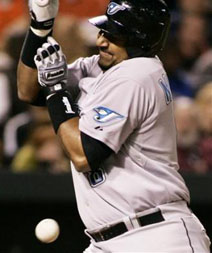
Jays’ batter Jose Molina gets hit by a pitch thrown by Orioles starting pitcher David Hernandez, with bases loaded in third inning, April 10. REUTERS/Joe Giza.
Notwithstanding the team’s impressive start (five wins and one loss at the time of this posting, just before the opening home game tonight) this year promises to be somewhat of a crossroads in an attempt to mend fences and win back Toronto’s core baseball fans. In this playoff-starved largest city in Canada, where all professional sports teams are at the moment on the outside looking in, there is a massive void to be filled.
It was easy to support the 1985-93 teams because of their winning ways and the state-of-the-art new stadium. Baseball games became a social event and part of the city’s conversation. Even non-fans could go to what was then called the Sky Dome and be a part of the “scene.” But, since then, it’s been difficult to be a Blue Jays fan.
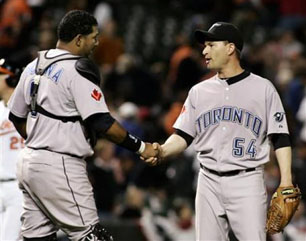
Jays catcher Jose Molina (l) congratulates relief pitcher Jason Frasor at the end of Jays’ April 10 win over Orioles. REUTERS/Joe Giza.
Cito Gaston enters the final season of his storied managerial career with the task of steering the franchise towards the future. Development is the key and fourth is as high as this bunch can dream of attaining. Ultimately that might not be a bad thing as the public has finally been told exactly what is going on. The biggest show of good faith by Jays’ fans this year will be to support a team that they know is not all that good now but has the ability and potential to be good (even very good?)Â in two or three years.
Still, buying tickets for an expected 90-loss team is tough to expect in this economy. It will no doubt be interesting. The real question is whether the Rogers ownership will be patient and committed enough to put up with empty stadiums and low TV ratings until fortunes turn. Meanwhile, some of us will of course keep going to the games: Onward then (and upward) to the home opener tonight … !
Some related sources:
www.yourdictionary.com
Baseball statistics at Baseball-Reference.com
History of the Toronto Blue Jays
Show Me the Money: Economics and Professional Sports, Raymond Sauer Clemson University
Blue Jays welcome White Sox for home opener
Robert Sparrow is a Toronto marketing analyst and noted local authority on the sporting life.
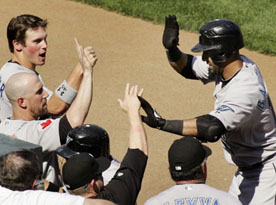
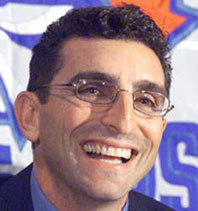
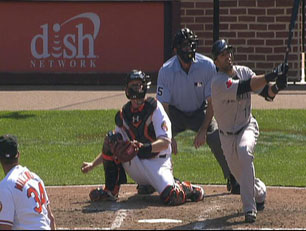
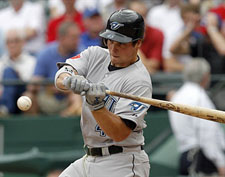
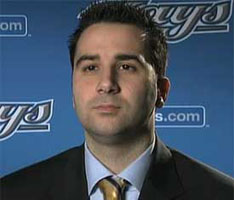
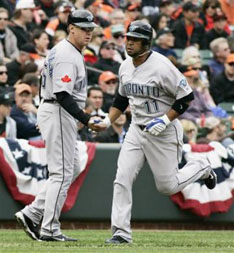


That first chart made me cry.